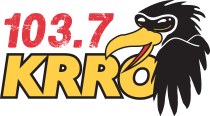Midcontinent ownership
In May 1950, Midcontinent Broadcasting, owner of KELO (1320 AM), filed the first application to the Federal Communications Commission (FCC) for a television station in South Dakota. [2] The application would not be considered for several years, as the FCC was in the midst of a four-year freeze on the grant of new TV station applications, but no opposition was received when the freeze was lifted in April 1952, and KELO-TV received a construction permit on November 20, 1952. [3] Construction proceeded quickly, though a change in the antenna specified required a different type of tower than was originally specified. Renovations were made to the existing KELO radio studios at 8th Street and Phillips Avenue, which had been planned for future television use. [4]
KELO-TV began broadcasting on May 20, 1953, after putting on a test pattern the day before; it was a primary affiliate of NBC, matching KELO radio, though it also carried programs from CBS, ABC, and DuMont. [5] [6] There were no television cameras or local studio programs because they were too expensive; it was two years before the station had its own cameras. [7] Power was increased in 1954, extending service to many rural areas outside of Sioux Falls, and the station also became interconnected with network coaxial cable to make live broadcasts possible. [8] Midcontinent partner Joe L. Floyd became nationally recognized for his advertising in trade publications, designed to help KELO radio and television court sponsors and their programs: the ads featured Floyd smoking a cigar with the tagline, "I'm Joe Floyd. I consider myself a helluva salesman." [9] The ads were recognizable enough that mention of them was made in Broadcasting magazine's obituary upon his death in 1992. [10]
Shortly after, in late 1954, Midcontinent began applying for additional full-power stations in eastern South Dakota as part of a strategy to increase the station's audience. [7] In December 1954, it applied to build KDLO-TV at Florence to serve Watertown; [11] that station began broadcasting on September 28, 1955. [12] [13] This occurred even though KELO-TV had lost its original tower in a storm and needed temporary facilities just to send its programs to Florence. [14] KELO then filed in April 1956 to move channel 6 from Pierre to Reliance; [15] fending off overtures from other stations in the area, [7] the construction permit was approved in December 1956, [16] and KPLO-TV began broadcasting on July 12, 1957. [17] The addition of these facilities expanded the coverage area and vaulted Sioux Falls into the top 100 media markets in the United States, making the KELO stations highly profitable. [7] [9] KELO-TV and its satellites perfectly matched the flow of goods through South Dakota, which centered on Sioux Falls, boosting advertising revenues; this would not be the case when Midcontinent attempted to replicate the formula with WKOW-TV in Madison, Wisconsin, where Madison was not the state's primary merchandising hub. [7] The transmitters gave KELO a coverage advantage that persisted for decades. For most of the analog broadcasting era, it was the only station that could be seen over-the-air in some form throughout the market. In contrast, as late as 2019, a third of the market—some 200,000 viewers—could not receive both KSFY-TV and KDLT-TV over-the-air. [18]
These new transmitters brought growing audiences to KELO-TV's local programming. In 1955, Midcontinent sent Dave Dedrick to the other station it owned at the time, WMIN-TV in Minneapolis. That station, also on channel 11, had a Captain 11 children's show. Dedrick, who also served as a weatherman for KELO, shadowed the children's host in Minneapolis, then returned to Sioux Falls to start his own Captain 11 . [19] In Sioux Falls, the program ran for 41 years, enduring decades of changes in children's television and Dedrick's own struggles with alcoholism, before his retirement in December 1996, culminating a 52-year involvement with KELO radio and television. [20] [21] [22] One local program was shared between two stations: The Big Bowl, a bowling program in which Sioux Falls contestants faced off against those from Sioux City, Iowa, produced by that city's KVTV/KCAU-TV. [23]
KELO radio and television switched their primary affiliations to CBS beginning in September 1957, though they remained NBC primary affiliates through June 1958 and KELO-TV continued to provide programs from all networks. [24] CBS had made a good offer at the same time that NBC denied Floyd an increase in network compensation fees for carrying its programming, fees that Floyd felt justified based on the station's performance. [7] New studios were built at 13th and Phillips streets in 1959. [25]
The station received competition when KSOO-TV (channel 13, now KSFY-TV) began in July 1960 as the new NBC affiliate. [26] A full-time ABC affiliate was not broadcast in the region until 1967, when KCAU-TV in Sioux City switched from CBS. It did so in part because KELO-TV was building a 2,000 feet (610 m) broadcast tower at Rowena in collaboration with KSOO-TV. [27] [28] [14] The Sioux City station advertised in the Argus Leader in Sioux Falls, staking a claim to be the ABC affiliate for both Sioux City and Sioux Falls. [29] [lower-alpha 1] Local programs were telecast in color from KELO-TV for the first time in September 1968. [32]
A guy wire on the KELO–KSOO tower at Rowena was clipped by a North Central Airlines airplane on June 24, 1968, and collapsed; the aircraft landed safely on one engine. [33] KELO-TV reverted to its former site near Shindler, South Dakota, for 11 months while the Rowena tower was rebuilt; litigation promoted by Midcontinent against North Central Airlines related to damages from the reduced coverage area stretched into January 1975. [34] That month, on January 11, the Rowena mast toppled again, this time in an ice storm; KSFY-TV, with no backup facility, found itself suddenly unable to air Super Bowl IX, and arrangements were made for KELO to telecast the contest. [35] Again, KELO-TV broadcast from the Shindler tower until December, when the replacement was put into service. [36] Ice storms have since felled other towers used by KELO-TV's satellites; KDLO-TV lost its tower in 1977 [37] and again in December 2022, [38] while KPLO-TV lost its tower on Medicine Butte in 2010 and did not broadcast for two months. [39]
While Midcontinent had first received and surrendered a permit for a Rapid City TV station in 1954 [40] and then obtained an option on a transmitter site in Rapid City in 1962, [41] KELO-TV did not expand to western South Dakota until September 1981, when it launched KPLO-TV translator K15AC. This brought CBS programming back to the area; the last full-time CBS affiliate in that market had been KRSD-TV, which closed in February 1976. [42] [43] K15AC was upgraded to a full-power station as KCLO-TV in November 1988. [44] KCLO-TV initially aired programming on an hour delay from KELO in order to timeshift it for the Mountain Time Zone, unlike the translator, [45] but this practice was abandoned permanently in January 1991 amid the Gulf War. [46]

















